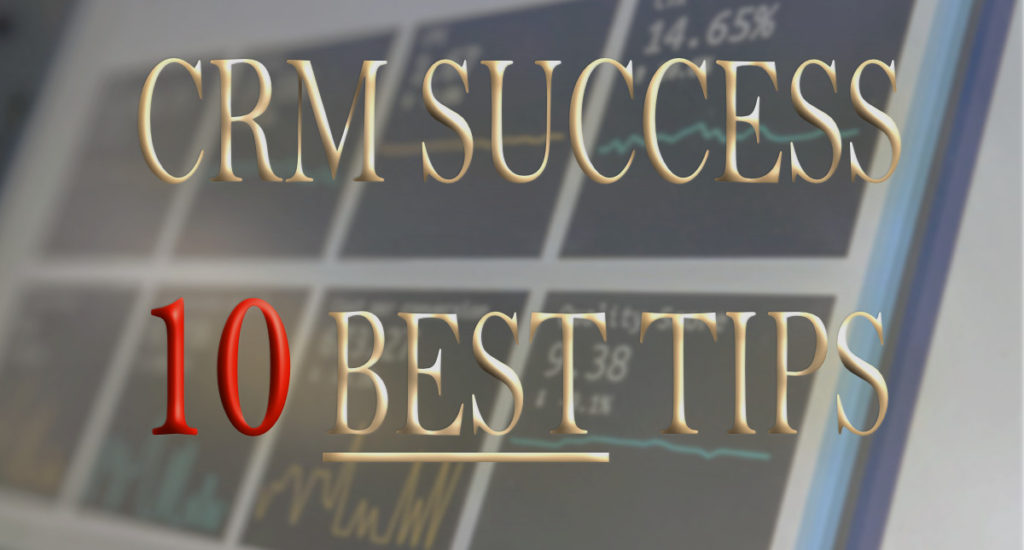
10 Best Tips for CRM Success
There are now dozens of different CRM tools, yet, they are all similar in form and functionality. Some of them have a prettier user interface, and others give users more options to modify the views, but they all can be effective. That is if you know how to use them correctly.
In my work, clients continuously fall in the same areas. So, to save time, I have provided a “top ten” list of CRM tips.
10. Simplify: Do Not Force Fit Features You Do Not Need
Today’s cloud-based SaaS systems are not designed for one person, one company or even one industry. They are developed as a one size fits all application. This means that, by design, the majority of functionality will NOT apply to every customer. Always keep this in mind during the implementation, roll-out and training phases. Specifically:
- Keep forms minimal and flexible. For example, never require more than a couple fields to create a new record or opportunity. At best this frustrates employees and slows down their progress. At worst, they enter garbage data to get around requirements; or, they stop using the system all together.
- Use contextual information to eliminate fields. If a buyer is a middle-man versus a decision-maker, design the CRM system to remove unnecessary data points. Contextual information also allows for the ability to prioritize and score prospects more accurately.
9. Customize the System at Each Level
Out of the box, most solutions have some type of wizard to develop a baseline set-up. Usually it is the product of questions about your industry, size, salesforce, and objectives. While better than nothing, this is far from optimal.
You need to take the customization to the next level by incorporating your prior knowledge.
- Where do most of your leads come from?
- What data points will lead to the qualification of a lead to a prospect?
- Is your lead conversion process a group effort? Does the marketing team need to communicate with Sales for certain leads?
- If 80% of clients require the same templates, can the tabs be reordered to lead with these?
8. Automate Routines to Better Leverage Time
The more time you spend in sales, the more you understand the phase, “time is money”. Each time you have to find, customize and send a document manually is another few seconds you could have been converting leads. Get ahead of the day with a few processes:
- Create workflow rules. If the same steps in a process is done four out of five times, and sometimes even just two out of three times, eliminate the manual steps. Do not sweat the small number of leads that do not fit in. These can be delegated to others if needed
- Develop groups for email alerts and notifications. Tag your contacts so they can automatically be updated with relevant news, updates and promotions with a single click.
7. Unify Data Sources for Quality Information
Every organization has several data sources with customer information. These can be in the form of Outlook contact databases to local spreadsheets from past client events. You need to find and merge these disparate data sources. This will build a complete unified system. The output can then provide insights into customer data that looks at a person in multiple dimensions. A few companies have done this so well that the information on a single person is too detailed and privacy concerns are brought up.
6. Integrate and Aggregate
The CRM system has more importance if there is full integration with 3rd party platforms. For example, can see all email communications by accessing Gmail or Office365? Can essential LinkedIn background information be pulled to find mutual likes? You should also keep the relevant customer emails housed in the CRM tool to communicate with context.
5. Ensure Data Security
The reasons to protect your data are exponentially more important today. Reputation damage for leaking personal information is just one reason. Keeping data secure also gives your internal team confidence that each individual can use the system without their contacts or information being stolen. Users will revert to prior record keeping systems if they don’t trust their own firm to protect their notes. Some best practices include:
- Restrict access based on IP addresses. Make sure data is accessible only from select secure networks. This doesn’t mean remote or mobile users won’t have the same access. Just that a VPN or secure tunnel will be required.
- Enable two-factor authentication (2FA) for important accounts. This protects against phishing, social engineering and brute-force password attacks. It secures your logins from attackers exploiting weak credentials. Fortunately, this is simple to set-up today. Companies such as Microsoft, Google and Cisco (via Duo) have various solutions.
- Set data access based on roles and groups in the CRM system. By using roles instead of actual names for security, it is easy to track and reassign people.
- Establish data share permissions for each role
- Run continuous data back-ups on a continuous basis to ensure no data is lost
4. Analyze the Analytics
Most professional CRM packages today have modules that can aggregate and assess all customer data. The key is to identify the areas to track that will have the biggest impact. The four common areas are:
- Profitability Analysis: Metrics that show which customers contribute to the highest profit over time. It should include not only a customer’s revenue contribution, but also the resource expenses dedicated to the customer in return.
- Customer Segmentation: How customers can be divided to buy specific products or services
- Personalization: The unique ways each customer can be marketed to based on their individual data and the secondary data about their preferences. The work in artificial intelligence has made this an exciting area.
- Predictive Modeling: Leveraging engagement levels and response types to guess likely future success from segments of customers.
Basic information such as open rates and click-through rates should also be incorporated into the CRM system to measure engagement and interest.
3. CRM System Quality is a Bi-product of Clean and Complete Data
The overall credibility of any CRM system starts and ends with the data, period. If users cannot trust the data that goes into the system, they will not use it. Further, corrupt information will pollute downstream integrations and cause operational issues for connected services. Data quality should be prioritized prior to the CRM even being turned on. Here are a few essential tips to mitigate data risk:
- Scrubbing the data to remove duplicates, eliminate formatting, correct spelling errors, and add proper data structure should be performed PRIOR to any initial data import process from the legacy system. Proper schemas, nomenclatures, and mappings should be discussed first. Then the data can be prepped and approved in advance of a data import.
- Assign a data steward who can oversee mass data entries and reverse data entries and updates before they propagate through internal systems and destroy the perception of information quality.
- Evaluate the data derivatives. Data entry processes, metadata (data describing the data points), and data definitions should be reviewed every quarter. These items can sometimes have double meanings. Many functional areas view data in different ways (for example, Marketing vs Sales). In order to assist, a glossary of terms and basic entry processes should be attached to the CRM help module.
2. Stay Ahead, or Fall Behind
Change is the only constant. This is especially true with technology. Just look back five years and you will notice that two-thirds of the enterprise products are no longer supported. They still exist but sticking with the products or their outdated business processes is a risky, and costly, gamble.
There are now new areas, such as Artificial intelligence, that are no longer fads. All major CRM providers have added these into their core products. Soon they will be just as common as a contact database.
Today organizations need to look at changes from all angles. For example, see what products are emerging and how they can make their data points stronger.
- Will one solution solve where prospects are found or where prospects find your firm in a more efficient manner?
- Can another solution automate communications with customer segments?
- What tools can best reassess your keywords to continue to rise in Search Engine Optimization arithmetic
1. Use the CRM System!
The most obvious tip is the most important one. Yet clients struggle the most with basic CRM adoption.
Reasons vary. Some think their peers, or their firm, will steal their information. Others have tried and true established manual methods to track leads. In addition, many organizations do not communicate the changes in a clear manner.
Bottom Line: Require the CRM tool to be part of Sales and Marketing processes, then figure out how to enforce the changes. The means to the end can be with carrots or sticks. Assess your organization, the corporate culture, and then develop a change management plan accordingly.
———-
These CRM tips are in no way a complete list. However, in my experience, these usually have the biggest impact on performance.
Please let me know if you agree with these tips. I would also love to hear about additional ways to improve on CRM success.
About the author: David Apollon is the Managing Director at 9Nation Inc., a consulting firm founded to help Fortune 500 companies, as well as high growth organizations, with special technology and strategic projects. These programs include strategic IT initiatives such as ERP, CRM and cloud-based SaaS implementations. David has worked with more than 100 CIOs, CFOs, and CEOs handle strategic initiatives within a dozen industries. Over 80 corporate programs, projects and PMO initiatives have been delivered successfully in the past 20 years. For more information, David can be reached at davida@9nation.com.
